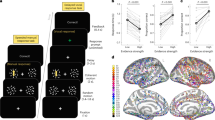Abstract
Electroencephalography (EEG) can provide information about which words or items are relevant for a computer user. This implicit information is potentially useful for applications that adapt to the current interest of the individual user. EEG data were used to estimate whether a linguistic or abstract stimulus belonged to a target category that a person was looking for. The complex stimuli went beyond basic symbols commonly used in brain-computer interfacing and required a variable assessment duration or gaze shifts. Accordingly, neural processes related to recognition occurred with a variable latency after stimulus-onset. Decisions involving not only shapes but also semantic linguistic information could be well detected from the EEG data. Discriminative information could be extracted better if the EEG data were aligned to the response than to the stimulus-onset.
Access this chapter
Tax calculation will be finalised at checkout
Purchases are for personal use only
Preview
Unable to display preview. Download preview PDF.
Similar content being viewed by others
References
Picton, T.W.: The p300 wave of the human event-related potential. J. Clinical Neurophysiology 9(4), 456–479 (1992)
ibbly - Pseudo-words. (acc: September 18, 2014) http://ibbly.com/Pseudo-words.html
Fawcett, T.: An introduction to ROC analysis. Pattern Recogn. Lett. 27(8), 861–874 (2006)
Friedman, J.H.: Regularized discriminant analysis. J. Am. Stat. Assoc. 84(405), 165 (1989)
Schäfer, J., Strimmer, K.: A Shrinkage Approach to Large-Scale Covariance Matrix Estimation and Implications for Functional Genomics. Statistical Applications in Genetics and Molecular Biology 4(1) (2005)
Blankertz, B., Lemm, S., Treder, M., Haufe, S., Müller, K.-R.: Single-trial analysis and classification of ERP components – a tutorial. NeuroImage 56(2), 814–825 (2011)
Author information
Authors and Affiliations
Corresponding author
Editor information
Editors and Affiliations
Rights and permissions
Copyright information
© 2015 Springer International Publishing Switzerland
About this paper
Cite this paper
Wenzel, M.A., Moreira, C., Lungu, IA., Bogojeski, M., Blankertz, B. (2015). Neural Responses to Abstract and Linguistic Stimuli with Variable Recognition Latency. In: Blankertz, B., Jacucci, G., Gamberini, L., Spagnolli, A., Freeman, J. (eds) Symbiotic Interaction. Symbiotic 2015. Lecture Notes in Computer Science(), vol 9359. Springer, Cham. https://doi.org/10.1007/978-3-319-24917-9_19
Download citation
DOI: https://doi.org/10.1007/978-3-319-24917-9_19
Published:
Publisher Name: Springer, Cham
Print ISBN: 978-3-319-24916-2
Online ISBN: 978-3-319-24917-9
eBook Packages: Computer ScienceComputer Science (R0)




